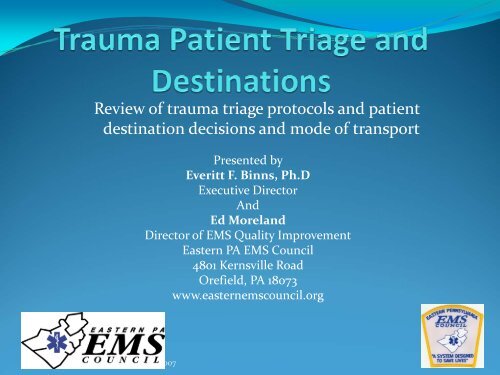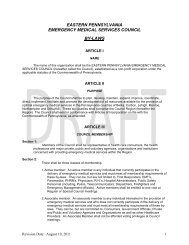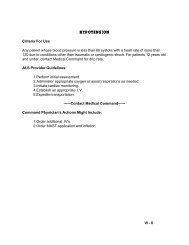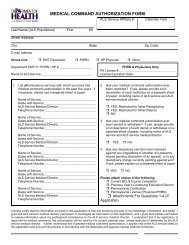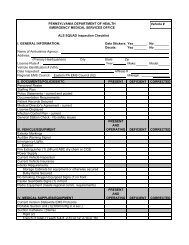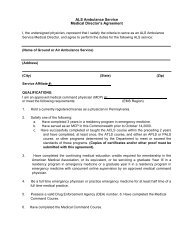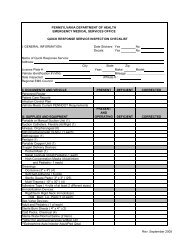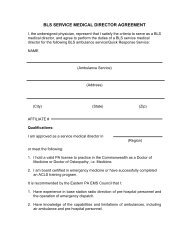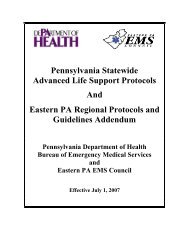Trauma Patient Triage and Destinations - Eastern EMS Council
Trauma Patient Triage and Destinations - Eastern EMS Council
Trauma Patient Triage and Destinations - Eastern EMS Council
- No tags were found...
You also want an ePaper? Increase the reach of your titles
YUMPU automatically turns print PDFs into web optimized ePapers that Google loves.
Review of trauma triage protocols <strong>and</strong> patient<br />
destination decisions <strong>and</strong> mode of transport<br />
Presented by<br />
Everitt F. Binns, Ph.D<br />
Executive Director<br />
And<br />
Ed Morel<strong>and</strong><br />
Director of <strong>EMS</strong> Quality Improvement<br />
<strong>Eastern</strong> PA <strong>EMS</strong> <strong>Council</strong><br />
4801 Kernsville Road<br />
Orefield, PA 18073<br />
www.easternemscouncil.org<br />
Copyright <strong>Eastern</strong> PA <strong>EMS</strong> <strong>Council</strong>, 2007
Objectives<br />
• Review of <strong>Trauma</strong> patient Categories<br />
• Review of <strong>Trauma</strong> Center classifications <strong>and</strong><br />
definitions<br />
• Review of non‐trauma air ambulance protocol<br />
• Review of destination decisions <strong>and</strong> modes<br />
• Examples<br />
• Discussion<br />
Copyright <strong>Eastern</strong> PA <strong>EMS</strong> <strong>Council</strong>, 2007
<strong>Trauma</strong> <strong>Patient</strong> Categories<br />
• Currently three (3) categories of trauma patients<br />
• Category I=Life threatening injuries<br />
• Category II=Mechanism of injury with increased index<br />
of suspicion<br />
• Category III=Minor trauma<br />
• Found in Statewide Protocol 180<br />
• We’ll come back to this later<br />
Copyright <strong>Eastern</strong> PA <strong>EMS</strong> <strong>Council</strong>, 2007
Category I <strong>Trauma</strong> <strong>Patient</strong>s<br />
• Does not follow comm<strong>and</strong>s (motor GCS ≤ 5)<br />
• Hypotension, even single episode<br />
– SBP
Category II <strong>Trauma</strong> <strong>Patient</strong>s<br />
• Death of another occupant in same vehicle<br />
• Auto vs. pedestrian (bicycle) injury with significant impact<br />
• Pedestrian thrown/ run over<br />
• Extrication time > 20 minutes<br />
• Falls > 20 feet<br />
• Ejection from vehicle<br />
• Vehicle rollover<br />
• High‐energy crash<br />
• Motorcycle crash with separation of rider from motorcycle<br />
• Rigid, tender abdomen<br />
• Age 55 y/o<br />
• Combination of trauma <strong>and</strong> burns<br />
• Known heart disease, CHF, COPD<br />
• Bleeding disorder or taking coumadin or heparin<br />
• Pregnancy > 20 weeks<br />
• Amputation of fingers with possibility of reattachment<br />
Copyright <strong>Eastern</strong> PA <strong>EMS</strong> <strong>Council</strong>, 2007
Copyright <strong>Eastern</strong> PA <strong>EMS</strong> <strong>Council</strong>, 2007
<strong>Trauma</strong> Centers<br />
• Regulated <strong>and</strong> Recognized by Pennsylvania <strong>Trauma</strong><br />
Systems Foundation (PTSF)<br />
• Legislatively m<strong>and</strong>ated organization that maintains<br />
the trauma registry, establishes <strong>and</strong> regulates trauma<br />
center requirements<br />
• Historically two levels of trauma centers<br />
• Good Samaritan‐Pottsville is first Level III in the<br />
Commonwealth<br />
Copyright <strong>Eastern</strong> PA <strong>EMS</strong> <strong>Council</strong>, 2007
<strong>Trauma</strong> Centers<br />
• Level I<br />
• Residency Programs, research, literature publication<br />
• Specialties<br />
• Level II<br />
• No Residence requirements<br />
• No research requirements, no publications required<br />
• Less physician specialties <strong>and</strong> sub‐specialty<br />
requirements<br />
Copyright <strong>Eastern</strong> PA <strong>EMS</strong> <strong>Council</strong>, 2007
<strong>Trauma</strong> Centers<br />
• Level III<br />
• Designed to fill a void in trauma center availability to<br />
rural areas of the Commonwealth<br />
• Modeled after other state’s systems<br />
• Requires formation of trauma registry<br />
• Physicians, Nurses(ED, Surgery, other specialties)<br />
required to have additional training<br />
• Increased availability of equipment <strong>and</strong> specialties<br />
Copyright <strong>Eastern</strong> PA <strong>EMS</strong> <strong>Council</strong>, 2007
<strong>Trauma</strong> Centers<br />
• Level III<br />
• Not intended to replace or substitute for Level I or II<br />
trauma centers, but to augment<br />
• Increases access to enhanced care for patients that may<br />
not otherwise receive it<br />
Copyright <strong>Eastern</strong> PA <strong>EMS</strong> <strong>Council</strong>, 2007
<strong>Trauma</strong> Center Distribution<br />
• 28 Accredited <strong>Trauma</strong><br />
Centers (not including<br />
Good Samaritan)<br />
• 15 Level I<br />
• 11 Level II<br />
• 8 Pediatric (additional<br />
qualification)<br />
Copyright <strong>Eastern</strong> PA <strong>EMS</strong> <strong>Council</strong>, 2007
Where do we go <strong>and</strong> how do we<br />
get there<br />
• Extremely Critical <strong>Trauma</strong> <strong>Patient</strong>s<br />
• (e.g. no airway, can’t ventilate, uncontrolled bleeding)<br />
–Transport to closest hospital<br />
ASAP<br />
Copyright <strong>Eastern</strong> PA <strong>EMS</strong> <strong>Council</strong>, 2007
Where do we go <strong>and</strong> how do we<br />
get there<br />
• Category I trauma patients<br />
• Still need to go to Level I or II <strong>Trauma</strong> Center<br />
• Utilize the mode that will get them to the <strong>Trauma</strong><br />
Center in the shortest time<br />
• Include warm up, enroute time, l<strong>and</strong>ing, h<strong>and</strong>off <strong>and</strong> flight<br />
time to trauma center for estimating flight time<br />
• Consider rendezvous with air ambulance en‐route to trauma<br />
center<br />
Copyright <strong>Eastern</strong> PA <strong>EMS</strong> <strong>Council</strong>, 2007
Where do we go <strong>and</strong> how do we<br />
get there<br />
• Category II <strong>Trauma</strong> <strong>Patient</strong>s<br />
– Transport to closest Level I, II, III <strong>Trauma</strong> Center if<br />
arrival is less than 45 minutes by ground<br />
– If arrival to a trauma center cannot be reached within 45<br />
minutes, then transport should be to the closest ED<br />
– Consider air transport if ground transport is greater<br />
than 30 minutes<br />
– Communicate ETA to receiving trauma center as soon as<br />
possible so that trauma center can mobilize their trauma<br />
team<br />
Copyright <strong>Eastern</strong> PA <strong>EMS</strong> <strong>Council</strong>, 2007
Where do we go <strong>and</strong> how do we<br />
get there<br />
• Category III <strong>Trauma</strong> <strong>Patient</strong>s<br />
• Transport to closest hospital<br />
Copyright <strong>Eastern</strong> PA <strong>EMS</strong> <strong>Council</strong>, 2007
How do we get them to the <strong>Trauma</strong><br />
Center<br />
• Category 1: consider air transport if:<br />
– Can deliver patient to TC faster than ground<br />
– GCS ≤ 8 <strong>and</strong> aircraft ETA to scene is less than ground<br />
transport time<br />
• Category 2: consider air transport if:<br />
– Transport by ground will take > 30 minutes<br />
• Avoid prolonged delays on scene awaiting arrival<br />
of air ambulance<br />
• Consider use of hospital/established helipads<br />
• Helicopter transportation is not indicated in<br />
traumatic cardiac arrest<br />
Copyright <strong>Eastern</strong> PA <strong>EMS</strong> <strong>Council</strong>, 2007
Transport Decision<br />
• No Air Ambulances will transport patients to Level III<br />
<strong>Trauma</strong> Centers<br />
• In Pottsville‐Transport <strong>Trauma</strong> patients to Good<br />
Samaritan<br />
• Outside Pottsville, consider Air Ambulance for<br />
Category I <strong>and</strong> II patients<br />
Copyright <strong>Eastern</strong> PA <strong>EMS</strong> <strong>Council</strong>, 2007
Copyright <strong>Eastern</strong> PA <strong>EMS</strong> <strong>Council</strong>, 2007
Copyright <strong>Eastern</strong> PA <strong>EMS</strong> <strong>Council</strong>, 2007
Non‐<strong>Trauma</strong> Use of Air Ambulance<br />
• Designed for STEMI <strong>and</strong> CVA<br />
• Allows for usage other than above<br />
• STEMI usage requires positive 12‐lead EKG<br />
• CVA usage requires normal activity within 2 hours<br />
• MUST BE COMMAND DIRECTED<br />
• Use caution, antecdotal reports of non‐trauma<br />
seizures, overdoses, <strong>and</strong> other invalid uses<br />
Copyright <strong>Eastern</strong> PA <strong>EMS</strong> <strong>Council</strong>, 2007
Case Review<br />
• Auburn<br />
• Fall from 15 feet, positive LOC, open tib/fib fx<br />
• BP 96/60, RR 28, PEARL, Left side chest tenderness<br />
• Weather is clear, sunny<br />
• Where <strong>and</strong> how does this patient get to the hospital<br />
Copyright <strong>Eastern</strong> PA <strong>EMS</strong> <strong>Council</strong>, 2007
Case Review<br />
• Ashl<strong>and</strong><br />
• 10 yom, struck while riding his bicycle<br />
• Chest pain, Resp distress, SPO2 95%, fx pelvis<br />
• BP 80/60,<br />
• Raining<br />
• Where <strong>and</strong> how<br />
Copyright <strong>Eastern</strong> PA <strong>EMS</strong> <strong>Council</strong>, 2007
Questions<br />
Copyright <strong>Eastern</strong> PA <strong>EMS</strong> <strong>Council</strong>, 2007


